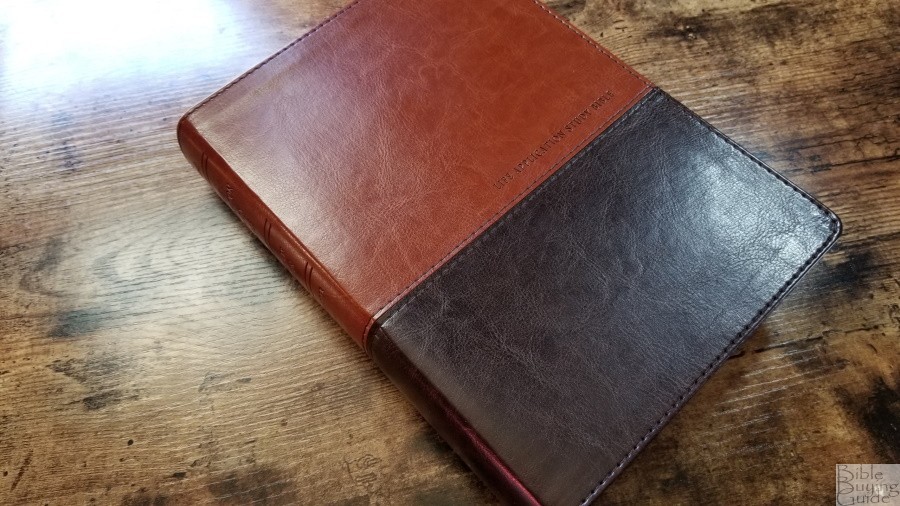
The Life Application Study Bible is one of the most popular study Bibles on the market. It’s available in several translations including the KJV. As the name suggests, it has a strong focus on personal application. It includes thousands of notes, biographies, maps, charts, and more. It’s also available with several cover options. I’m reviewing the KJV second edition in imitation leather, ISBN: 9781414375472, made in South Korea.
Tyndale provided this Bible in exchange for an honest review. I was not required to give a positive review, only an honest one. All opinions are my own.
_________________________________________________________
This Bible is available at (includes some affiliate links)
and many local Bible bookstores
_________________________________________________________
Table of Contents
- Video Review
- Cover and Binding
- Paper
- Typography
- References
- Footnotes
- Book Introductions
- Study Material
- Concordance
- Maps
- Conclusion
Video Review
Cover and Binding

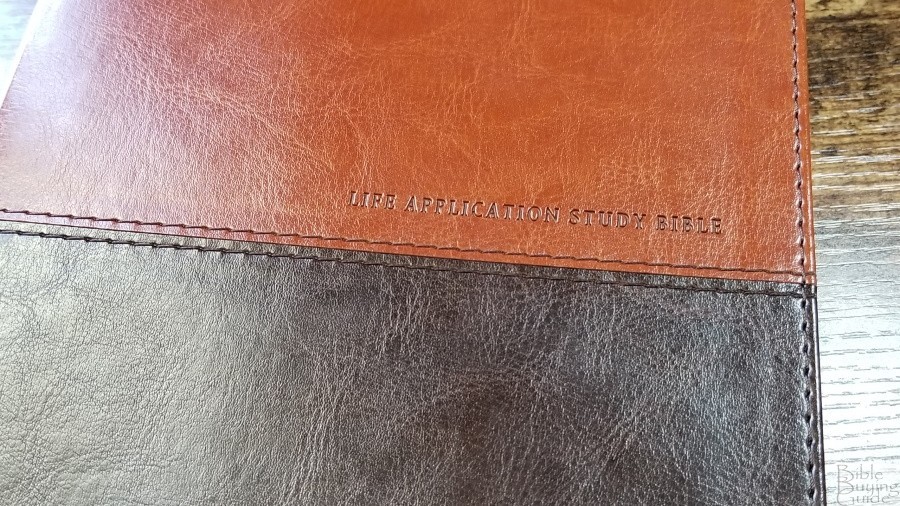

The cover is brown and tan TuTone imitation leather. Even though it’s imitation, it looks and feels elegant. It has a light grain pattern that gives it some color texture. The text is debossed into the front and the spine. It includes perimeter stitching. The liner is paste-down vinyl. It’s sewn and has no trouble staying open (although it will need some use before it stays open in Genesis 1). It has one brown ribbon. The overall size is 9.50″ x 6.75″ x 1.75″ and it weighs 3 lbs, 1 oz.
Paper
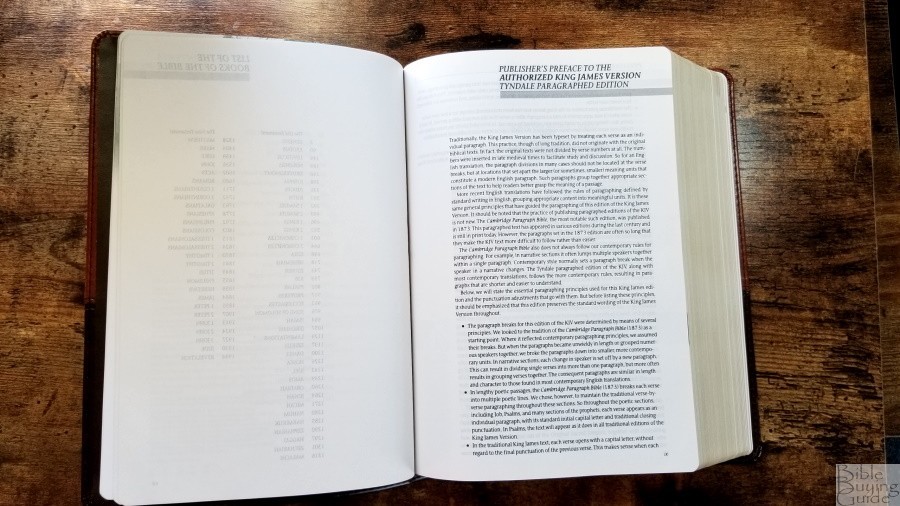
The paper is white in color and has a smooth feel. I’d guess it to be 30gsm or higher. There is no glare under direct light. It does have more show-through than I’d like. I think this is more noticeable because it doesn’t have line-matching. The page edges are gold gilt.
Typography
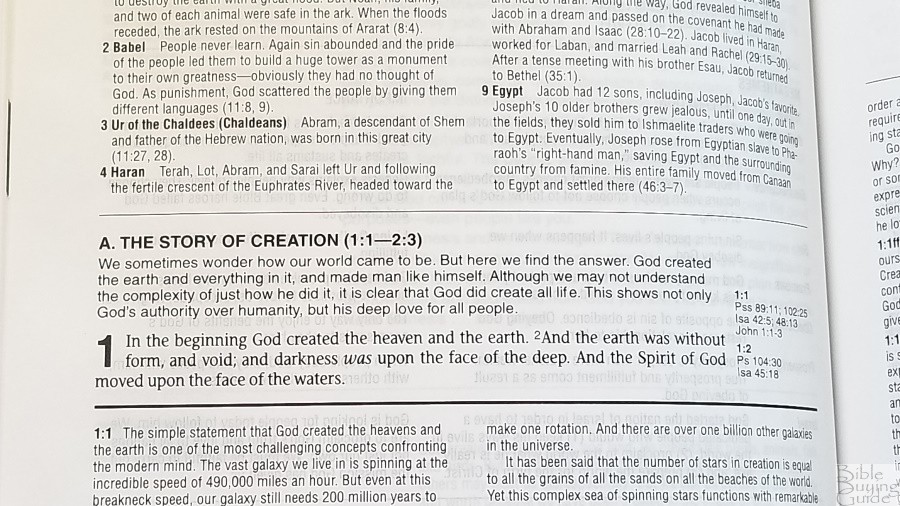
The text is presented in a single-column, paragraph format with poetry in a verse-by-verse layout. Dialog is set on individual lines as you’d see in a normal book. References are in the inner margin and footnotes are placed under the text. Commentary is placed under the text in two columns separated from the text by a horizontal line. The header includes the book name and chapter number in the outer margin and the page number in the inner margin, separated from the text with a horizontal line. If a page includes articles, they’re placed between the text and the commentary. The Harmony of the Gospels is built into the text of the Gospels. Major sections have an outline built-in and include a short paragraph to introduce them.

The text is 8-point. This is a red-letter edition. Both the black and the red are about a medium shade of darkness. There are no reference or footnote keys in the text. This greatly improves readability (especially when reading aloud). Rather than standard section headings, the text includes the outline with a number for the line in the outline. They’re a little too close to the text for my eyes to tell them apart easily.

It has between 16-18 words per line on average. This is more words than I consider optimal for readability, which for me, is between 10-12. Even 14 words would be a better target. There isn’t enough space between the lines to make it ideal to read, but it isn’t as difficult as I expected. Poetry is in verse-by-verse. At this word-count, the beauty of the poetic setting is mostly lost. Dialogue is set apart, which I always appreciate.
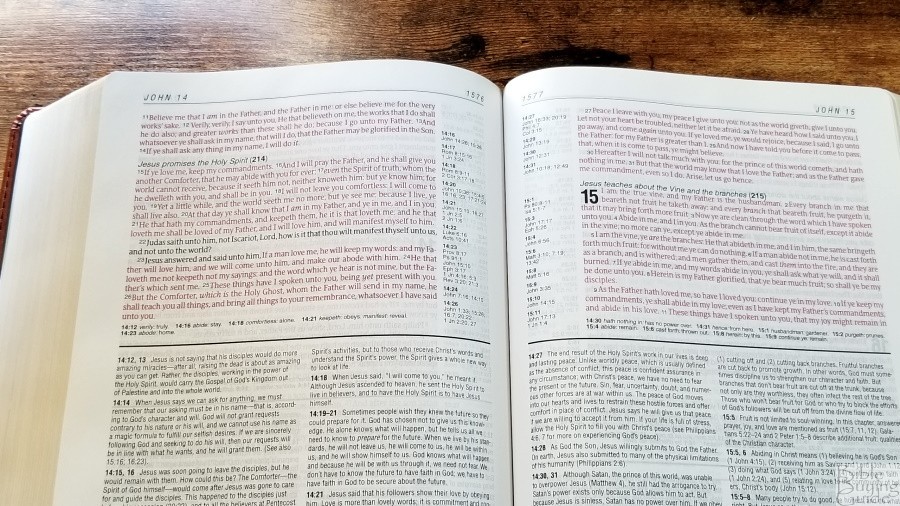
For teaching and preaching, it did take a few seconds to find the verse numbers. Having the cross-references next to the verses does help because it gives you an idea of where to look in the text. There are more words per line than what I find to be ideal, but I still prefer reading this to verse-by-verse. Preaching and teaching were easier than I expected. I think this is due to the text being on the flat part of the page. Line-matching would help a lot. Sometimes the outline in the text made it a touch difficult to find something.
References
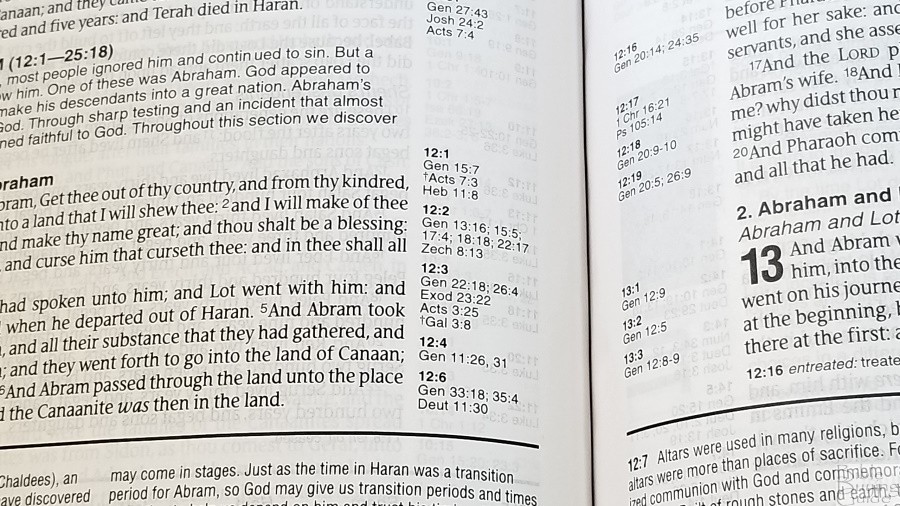
Cross-references are “side-column” and are placed in the inner margin. They’re placed next to the verses they correspond to and they’re printed in a stack. The verse numbers they go with are printed in bold, making them easy to find. They’re printed larger than many references. The text doesn’t have keys to the references. I find them easy to read and use.
Here are some example references to help you compare:
- Genesis 1:1 – Ps 89:11; 102:25; Isa 42:5; 48:13; john 1:1-3
- Deuteronomy 6:4-5 – Dt 45:35, 39; Matt 22:37; Mark 12:29-30; Luke 10:27; 1 Cor 8:4, 6
- Isaiah 9:6 – Dt 10:17; Neh 9:32; Isa 7:14; 26:3, 12
- Matthew 28:19 – x
- Mark 12:29-30 – Dt 6:4-5; Josh 22:5; Luke 10:27
- John 1:1 – Gen 1:1; Phil 2:6; 1 John 5:20
- John 3:16 – Rom 5:8; 8:32; 1 Jn 4:9-10; 5:13
- Acts 2:38 – Mark 16:16; Acts 3:19; 8:12; 22:16
- Rom 10:9 – Matt 10:32
- 1 John 1:1 – John 1:1, 4, 14; 20:30-31; 1 Jn 5:11, 13, 20
Footnotes

Footnotes are placed under the text in a smaller font. They include lots of definitions and explanations for words that have changed in meaning or are no longer in daily use. I’m glad they’ve included these because they make the KJV easier to understand. The only complaint I have is there aren’t any markings in the text (such as an asterisk used in most Bibles I’ve seen from Tyndale) to alert you to a definition. I do prefer an uncluttered text, but an asterisk would help.
Book Introductions
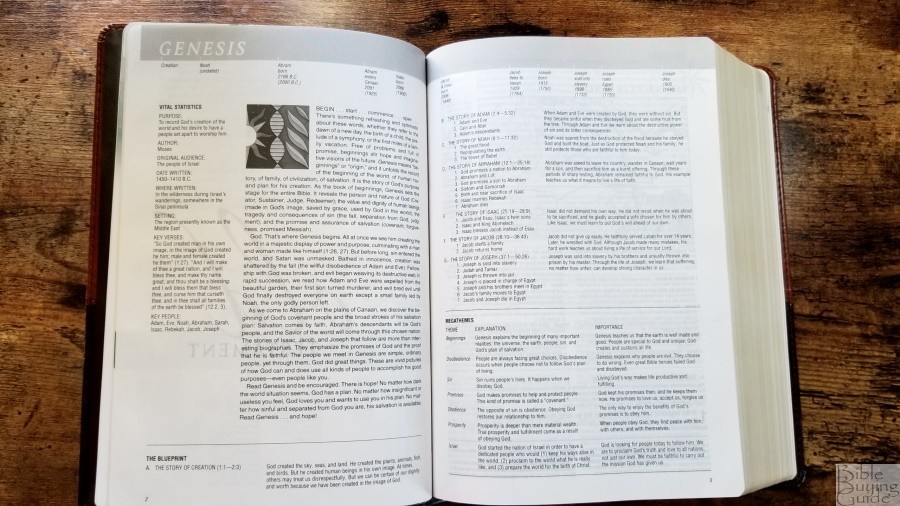
The book introductions look complex at first, but they’re actually simple and provide a lot of information that’s easy to see at a glance. Book introductions provide a timeline across the top of the page with the major events in the book and their dates. A set of vital statistics is placed in a sidebar. Several paragraphs describe the type of book it is, the main lessons to learn, and a takeaway. A blueprint shows an outline with a description of each section. Megathemes shows the main themes with an explanation and importance.
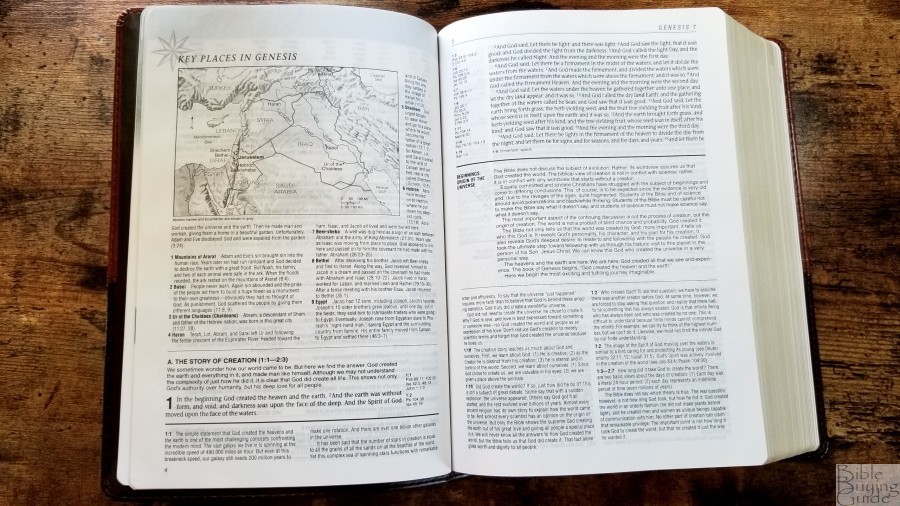
Another page shows a map with key places and includes a description of the locations. These are great for seeing the main points of a book to understand its message. Each book introduction has a decorative icon that was designed just for that book.
Study Material
The study material is where this Bible shines. It has lots of charts, notes, maps, profiles, indexes, and other tools. Most are within the text, while some are in the front, middle, or back.
In the Text
The text includes notes, personality profiles, charts, and maps. They’re placed under the text. The notes are 7-point.
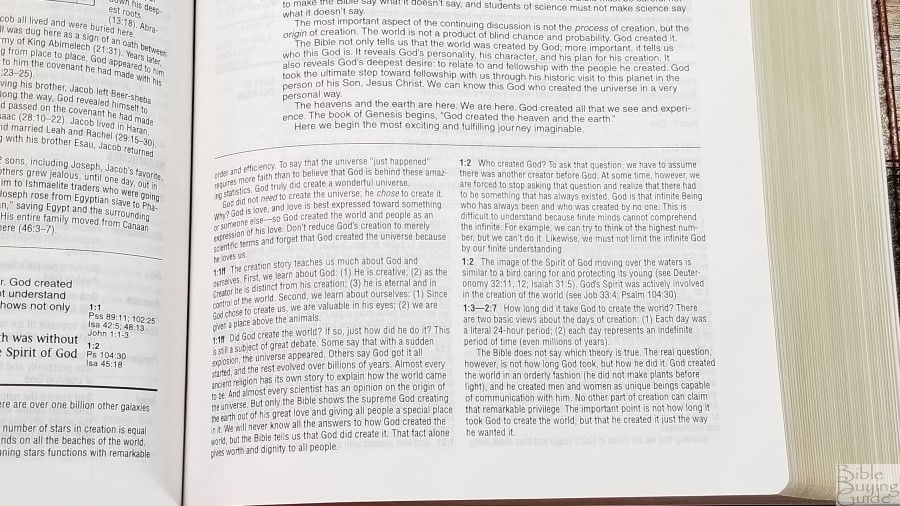
Life Application notes – These are the commentary at the bottom of the pages. There are thousands of notes that explain the text. The commentary has a devotional quality that almost always pushes for personal application. Those that do include theology don’t go into depth and only present one point of view (which seems to be mainstream evangelical from the examples I read).

Personality Profiles – These provide details of over 100 biblical characters. It includes a few paragraphs that highlight the key information about the person and then provide bullet points for their strengths and accomplishments, lessons from their life, vital statistics, and key verses. They include a graphic of a stylized person so they stand out.

Maps and Charts – It has 200 small grayscale maps that provide information about locations and events. They’re simple, but they’re easy to use. A short paragraph provides information about the content of the maps. It also has 260 charts that explain difficult concepts and relationships. Charts include a paragraph to explain them and provide references, descriptions, etc. They include a small graphic that’s just visible in the background. 8
In the front
In the front are the presentation and family pages, and the introductory pages.

Presentation Page – a thick page with a green-tinted photo, presentation lines, and a Scripture. The title is printed in gold.
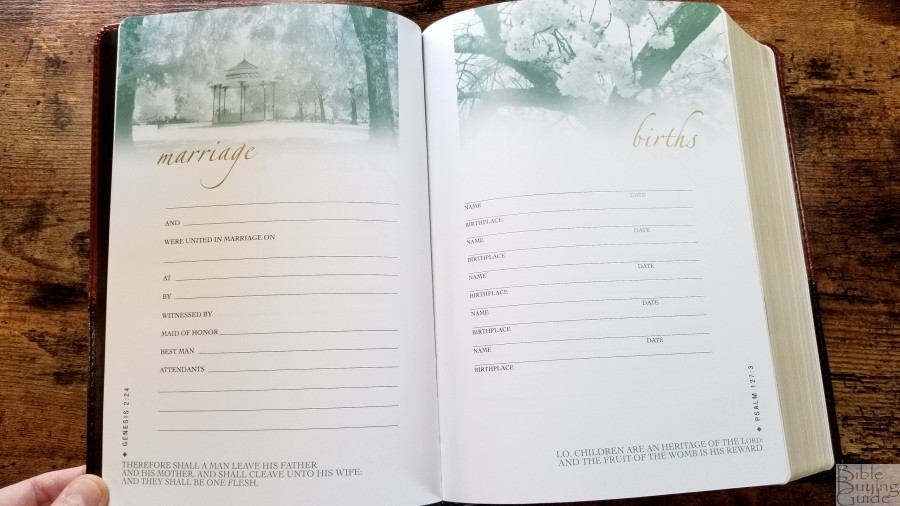
Family Records – designed the same as the presentation page and includes marriage, births, baptisms, deaths, the husband and wife family trees, and special memories.
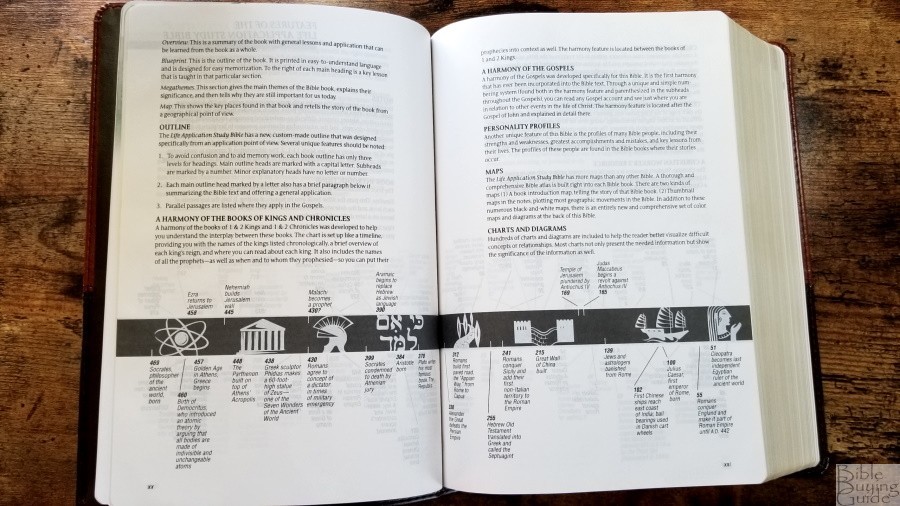
Articles and Charts – there are several pages that include an introduction, contributors, a Chronology of Bible Events and World Events, Why the LASB is Unique, What is Application, and the Features of the LASB.
In the Middle
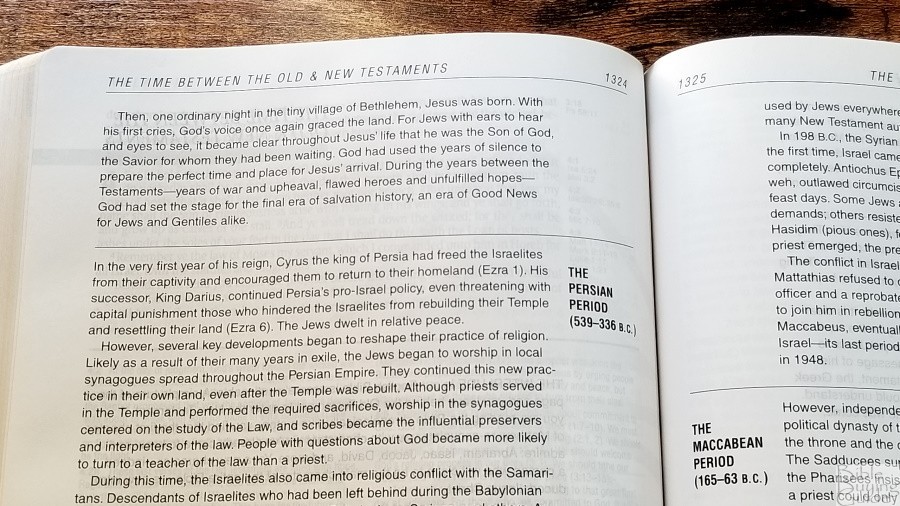
The Time Between the Old and New Testaments – This is a 4-page article that outlines the history between the testaments. It gives the dates and the main events with a few paragraphs to describe each one.
In the Back
In the back are lots of indexes and other tools.

Christian Worker’s Resource – This is several pages that help prepare you to witness to others. It gives a short explanation of basic doctrines, provides questions and answers, and shows how to use this study Bible to teach others. It includes good information about how to study for and develop a presentation to teach a class or small group using this Bible.
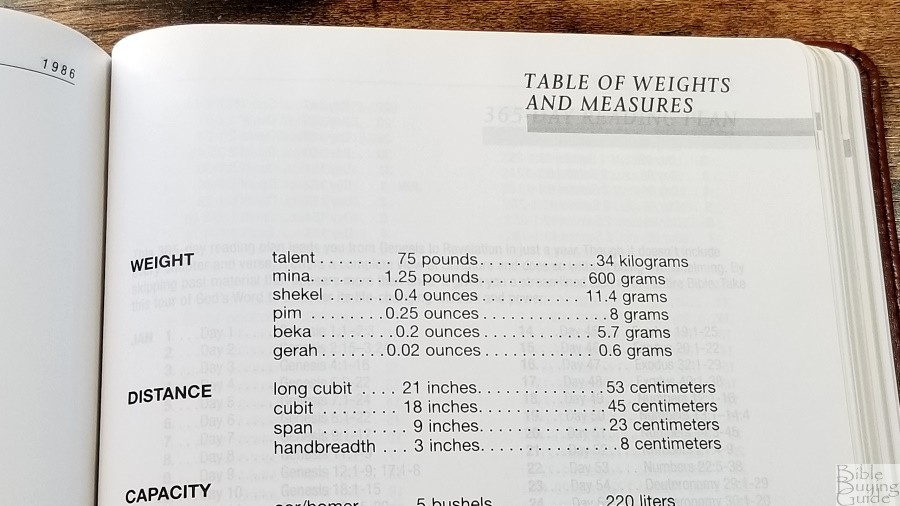
Table of Weights and Measures – A small table that shows weights, distances, and capacities for dry and wet measures.

365-Day Reading Plan – A reading plan that provides the date and the chapters to read for that day. It takes you through the Bible in standard order.
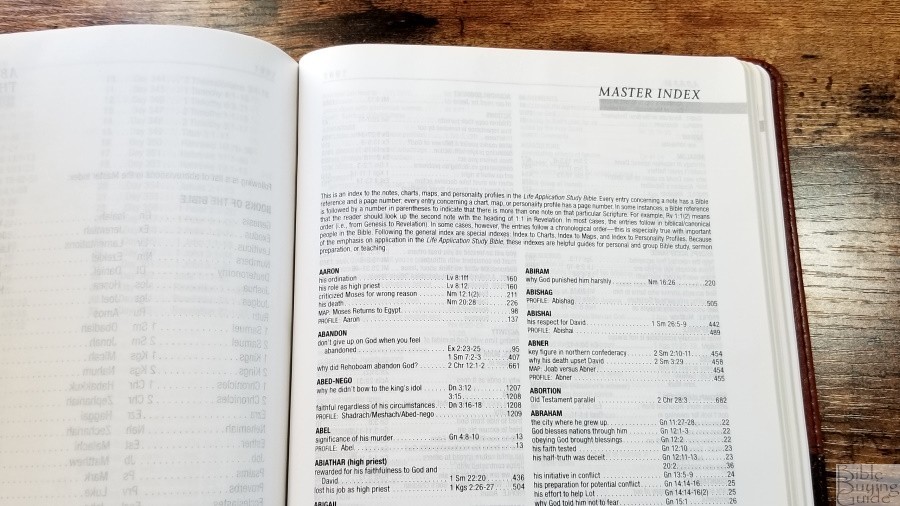
Master Index – This is an index to all of the topics that the notes cover. it breaks them into subtopics and provides the reference and page number.
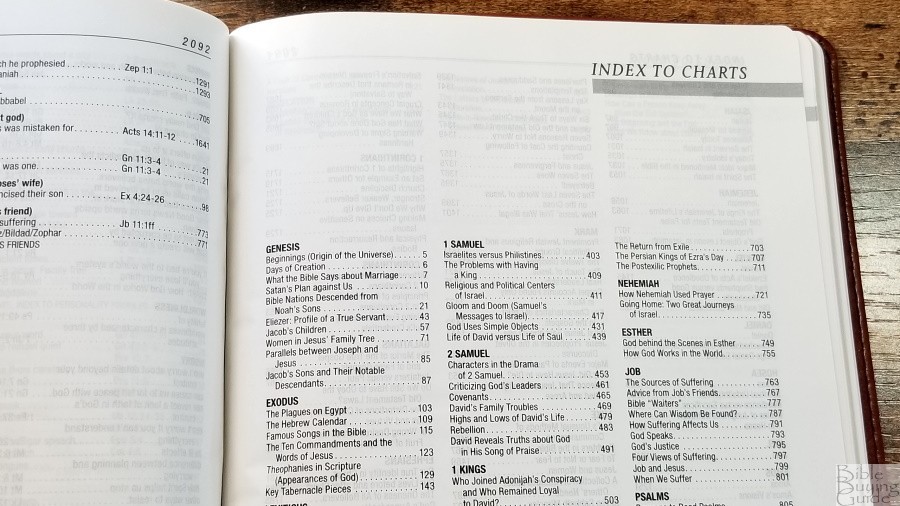
Index to Charts – An index to all of the charts that are placed in the notes throughout the Bible. It shows the book name, the titles for the charts, and page numbers.
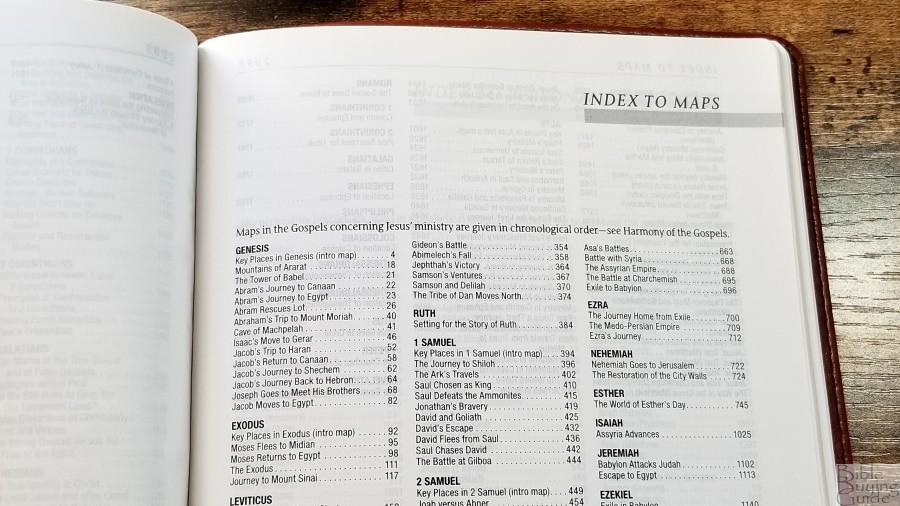
Index to Maps – An index to all of the maps that are placed in the notes. It shows the name of the book, the locations in that book, and the page number for each location.
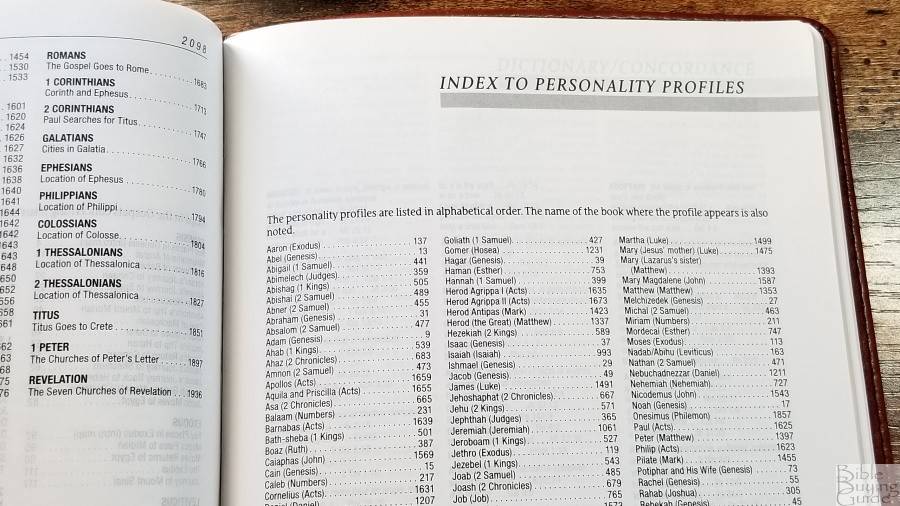
Index to Personality Profiles – An index to all of the biographies. It provides the names in alphabetical order and gives the page number for each person.
Dictionary/Concordance

The concordance is 42 pages with 3 columns per page. It doubles as a dictionary, providing a short definition to each entry. The entry is in bold. The definitions are short, but I find them helpful. It’s a fairly small concordance, but the other tools and indexes help make up for that. Here are a few example entries with the number of their references. I’ve included the definition to help you compare.
- Christ (Son of God, Messiah) – 18
- Christians (someone who belongs to Christ) – 3
- Faith (reliance, loyalty, or complete trust in God; a system of religious beliefs) – 65
- Faithful (firm in adherence, utterly loyal; those who practice faith) – 8
- God (eternal, infinite Spirit; Creator, Redeemer, Sovereign Lord) – 18
- God(s) (impotent pagen deity; graven image of one) – 12
- Godliness (devotion to God) – 6
- Godly (living according to God’s standards) – 11
- Praise (to worship, commend, or give honor to; an expression of the same)- 11
- Pray(est) (used as a function word to express politeness or emphasis in a request or question; to make supplication or petition to God) – 14
Maps
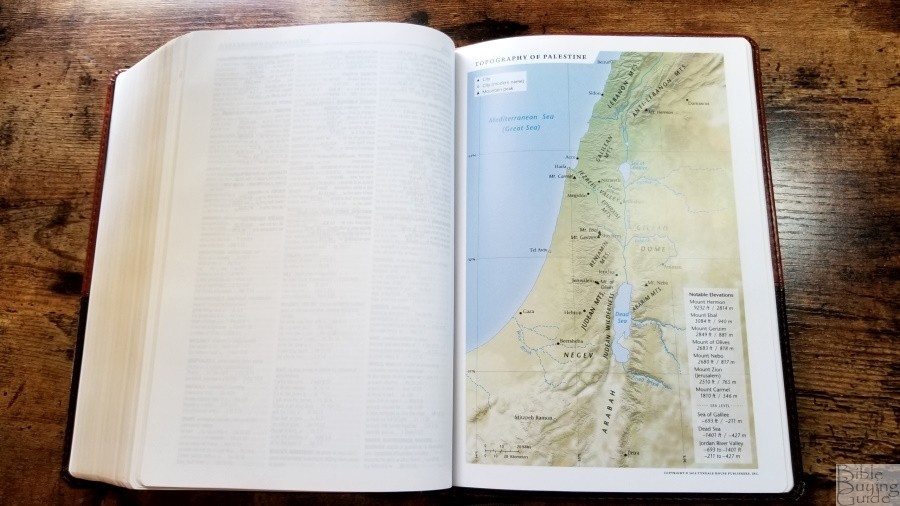


In the back as 16 pages with 19 color maps. They’re printed on thick semi-glossy pages with muted colors. They include cities, modern names of cities, mountains, elevations, average rainfall, Scripture references, routes, bird migrations, ancient roadways, cities of refuges, capitals, battles, dates, distance, events, territories, communities, etc. These maps do not include an index.
Maps include:
- Topography of Palestine
- Worlds of the Patriarchs
- Exodus from Egypt
- Twelve Tribes of Israel
- Conquest of Canaan
- United Kingdom
- Divided Kingdom
- Deportations and Returns Under Assyrian Babylon
- Assyrian and Babylonian Empires
- Greek Empire
- Palestine Between Old and New Testaments
- Old Testament Jerusalem
- New Testament Jerusalem
- Roman Division and Palestine
- Ministry of Jesus
- Paul’s Missionary Journey’s
- Paul’s Journey to Rome
- Roman Empire and the Spread of Christianity
- Israel and the Middle East Today
Conclusion
Tyndale’s KJV Life Application Study Bible is an interesting Bible. The layout is easier to read than I expected. I do think a shorter word-count per line would be better. I’d love to see it printed with line-matching and for poetry to be printed in stanzas rather than verse-by-verse. I prefer this design to the typical v-b-v layout because it improves readability. It does provide a lot of information. The notes only provide one point of view. Its strength is in personal application and character studies, which it does better than most study Bibles.
_________________________________________________________
This Bible is available at (includes some affiliate links)
and many local Bible bookstores
_________________________________________________________
Tyndale provided this Bible in exchange for an honest review. I was not required to give a positive review, only an honest one. All opinions are my own.










Hi Randy, I used to have the 2nd edition of the Life Application Study Bible. it was a great Bible, but mine was not sawn binding it was glued. And it fell apart after four months or so. I want to get the 3rd Edition that is out now, which is Saved Binding. but other than that I really did like it.Thank you for your review Sir.
What are the bold numbers in subject headings in the NT?
The letters are part of the outline in the book introduction. The numbers show the range of verses that are in that section of the outline.